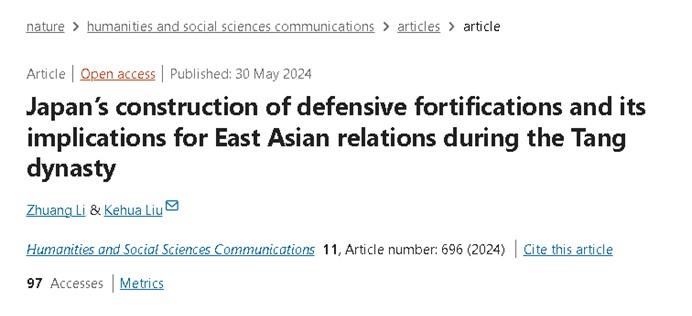近日,bv伟德国际体育官方网站在读博士生李庄在Nature子刊《Humanities and Social Sciences Communications》发表了题为“Japan’s construction of defensive fortifications and its implications for East Asian relations during the Tang dynasty”的研究论文。李庄为第一作者,指导老师刘克华教授为通讯作者,bv伟德国际体育官方网站为唯一署名单位。

长期以来,学者们普遍认为日本在白村江战后才开始大规模修建防御工事,然而,该论文通过考察中国、日本以及朝鲜三方史料提出,日本对外部威胁的防御意识可能萌发得更为久远。研究发现,公元七世纪,日本已经修筑了大量防御工事,这不仅是对日本国内冲突与变革的回应,也反映了它对外部力量的博弈与抗衡。该项研究从修筑防御工事的角度出发,为评估日本历史上的军事决策和政治决策提供了新的视角,对理解日本古代的地缘政治具有重要意义。
论文摘要:Japan’s construction of fortifications throughout its history has been a subject of scholarly interest. Japan has been building fortifications for generations, from Muzuki and stone fortifications at home to Japanese fortifications on the Korean peninsula. While it is commonly believed that the need for castle building in Japan emerged after the Battle of Baekgang, this paper suggests that Japan’s sense of external tensions predates this event. Specifically, this paper examines the construction of defensive fortifications at Itojo and Onojo during the Tang Dynasty and its implications for Japan’s relations with East Asia. Through an analysis of historical records and archeological evidence, this paper argues that the construction of Onojo may have begun as early as around AD 650, challenging the prevailing view in academic circles, which holds that Onojo was built after the defeat of Baekgang. By examining the development of Japan’s relations with East Asia during this period, this paper sheds light on the geopolitical significance of Japan’s construction of defensive fortifications.
(文/李庄、刘克华 编辑/张婷婷)


